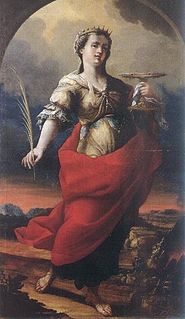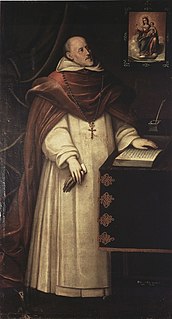Related Research Articles

Francisco de Zurbarán was a Spanish painter. He is known primarily for his religious paintings depicting monks, nuns, and martyrs, and for his still-lifes. Zurbarán gained the nickname "Spanish Caravaggio", owing to the forceful use of chiaroscuro in which he excelled.

The Spanish Golden Age is a period of flourishing in arts and literature in Spain, coinciding with the political rise of the Spanish Empire under the Catholic Monarchs of Spain and the Spanish Habsburgs. The greatest patron of Spanish art and culture during this period was King Philip II (1556–1598), whose royal palace, El Escorial, invited the attention of some of Europe's greatest architects and painters such as El Greco, who infused Spanish art with foreign styles and helped create a uniquely Spanish style of painting. It is associated with the reigns of Isabella I, Ferdinand II, Charles V, Philip II, Philip III, and Philip IV, when Spain was one of the most powerful countries in the world.

Juan Luna de San Pedro y Novicio Ancheta was a Filipino painter, sculptor and a political activist of the Philippine Revolution during the late 19th century. He became one of the first recognized Philippine artists.

The Order of Saint Jerome or Hieronymites is a Catholic cloistered religious order and a common name for several congregations of hermit monks living according to the Rule of Saint Augustine, though the role principle of their lives is the 5th-century hermit and biblical scholar Jerome.

Vicente Juan Masip was a Spanish painter of the Renaissance period. He is commonly considered the foremost member of the Valencian school of painters.

Vincenzio Carduccio was an Italian painter.

Juan Ribalta was a Spanish painter of the Baroque period. He was born and died in Valencia. His father, Francisco Ribalta, was a famous painter, active in the style of Caravaggio. Some sources said he was born in Madrid and later moved to Valencia. His mother Inés Pelayo died in 1601. Juan's works and style are similar to that of his father. He later painted Saint Sebastian at the Valencia Cathedral in 1616, later the small Adoration of the Shepherds and St. Peter, he also painted portraits including the poet Gaspar de Aguilar.

Friar Nicolás Borrás (1530–1610) was a Spanish Renaissance Catholic monk and painter, active in Valencia.

Friar Juan Andrés Ricci de Guevara, known as Friar Juan Rizi was a Spanish Benedictine monk, painter, and architect, in the Baroque style. He also wrote works on theology and geometry and may have been nominated to become a bishop.

Evaristo Muñoz Estarlich was a Spanish Baroque painter; a follower of the decorative style introduced to Valencia by Antonio Palomino. Some sources give his year of birth as 1671.

Francisco Camilo was a Spanish painter, the son of an Italian immigrant who had settled in Madrid. When his father died, his mother remarried, and Camilo became the stepson of the painter Pedro de las Cuevas.

Gregorio Fernández was a Spanish Baroque sculptor. He belongs to the Castilian school of sculpture, following the style of other great artists like Alonso Berruguete, Juan de Juni, Pompeyo Leoni, and Juan de Arfe.

Cristóbal de Villalpando was a Baroque Criollo artist from New Spain, arts administrator and captain of the guard. He painted prolifically and produced many Baroque works now displayed in several Mexican cathedrals, including the cathedrals in Querétaro and Mexico City, as well as a depiction of the Zócalo in Mexico City, showing the damage of the 1692 riot to the viceregal palace three years earlier.

Juan Correa (1646–1716) was a Mexican distinguished painter of the late seventeenth and early eighteenth centuries. His years of greatest activity were from 1671 to 1716. He was an Afro-Mexican, the son of a Mulatto or dark-skinned physician from Cádiz, Spain, and a free black woman, Pascuala de Santoyo. Correa "became one of the most prominent artists in New Spain during his lifetime, along with Cristóbal de Villalpando." Manuel Toussaint considers Correa and Villalpando the main exponents of the Baroque style of painting in Mexico. Correa was a very productive religious painter, with two major paintings in sacristy of the Cathedral of Mexico City, one of the Immaculate Conception and the other An Allegory of the Church. He also painted major works for the Jesuit church in Tepozotlan, Mexico. According to Toussaint, Correa is "important in achieving a new quality, in the creative impulse he expresses, and which one cannot doubt embodies the eagerness of New Spain for an art of its own, breaking away from its Spanish lineage. Here New Spain attains its own personality, unique and unmistakable." Correa was José de Ibarra's teacher.

Various types of visual arts developed in the geographical area now known as Mexico. The development of these arts roughly follows the history of Mexico, divided into the prehispanic Mesoamerican era, the colonial period, with the period after Mexican War of Independence, the development Mexican national identity through art in the nineteenth century, and the florescence of modern Mexican art after the Mexican Revolution (1910-1920).

Cristóbal Vela was a Spanish Baroque painter and gilder.

Cristóbal Hernández de Quintana (1651-1725) was a Spanish baroque painter, the most prominent representative of Baroque painting in the Canary Islands.

La Celestina is a 1996 Spanish drama directed by Gerardo Vera and written by Rafael Azcona, Gerardo Vera and Francisco Rico based on 1499 novel of the same title by Fernando de Rojas. Starring Penélope Cruz, Terele Pávez and Juan Diego Botto.

Cristóbal de Torres y Motones, OP was a Spanish-born prelate of the Catholic Church in New Spain. A member of the Dominican Order, in 1635 he was appointed archbishop of the Archdiocese of Santafé en Nueva Granada. There, he was one of the first bishops in New Spain to admit indigenous people to communion, and he later founded Del Rosario University in Bogotá.

Andrés Amaya was a Spanish Baroque painter in oils of religious subjects. He was active in the region of Castile and León, primarily in the city of Valladolid.
References
- ↑ Maxwell, Sir William. Annals of the Artists of Spain. p. 558.
- Bryan, Michael (1889). Walter Armstrong; Robert Edmund Graves (eds.). Dictionary of Painters and Engravers, Biographical and Critical. Vol. II L-Z. London: George Bell and Sons. p. 652.